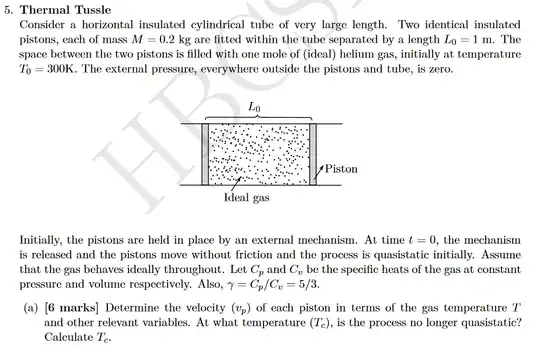For the process to be quasistatic and adiabatic the piston’s velocity cannot be greater than rms velocity of the gas. [...] Below this temperature, the piston’s velocity exceeds rms velocity, which indicates that the piston moves very rapidly. This is where the quasi-static limit will breaks down.
This is a rough estimate and IMHO cannot be viewed as a unique possible answer. For a process tot be quasistatic, the system should relax to equilibrium much faster than the rate of the process, i.e., the system relaxation time should be much smaller than the speed of the process. Since the relaxation necessarily means a change of entropy, and thus no process is really quasistatic, unless it is infinitely slow. The way the concept of a quastistic processes is used in practice is by assuming that the process is slow enough that the entropy generated is negligible for the required precision.
In this problem, whatever is the precision threshold, it is satisfied at the beginning, when the gas is in equilibrium, and is eventually broken, as the pistons accelerate. One may reason that, as a piston moves, it leaves behind it an empty space, which has to be filled by the gas. There are always molecules with speeds lower than that of the piston, which lag behind - so the distribution of the velocities (and density) behind the piston is not a Maxwell-Boltzmann one. How far it deviates from Maxwell-Boltzmann depends in the piston velocity - obviously, this deviation is impossible to ignore when the piston speed exceeds rms, and thus the quasistatic approximation does not apply. However, one could argue that in any practical calculation it becomes unapplicable much earlier.
One could try to actually model the trajectories of the particles following the approach of this answer to Proof of pressure of ideal gas from first principles)... however, in this case one still doesn't take into account relaxation, that is the distribution of energies changes only via the exchange of momentum in the collisions of molecules with the piston, and likely stops being Maxwell-Boltzmann - in which case we cannot define temperature. It could be interesting to work out this model in details (and this could probably score some points with the olympiad jury.)
